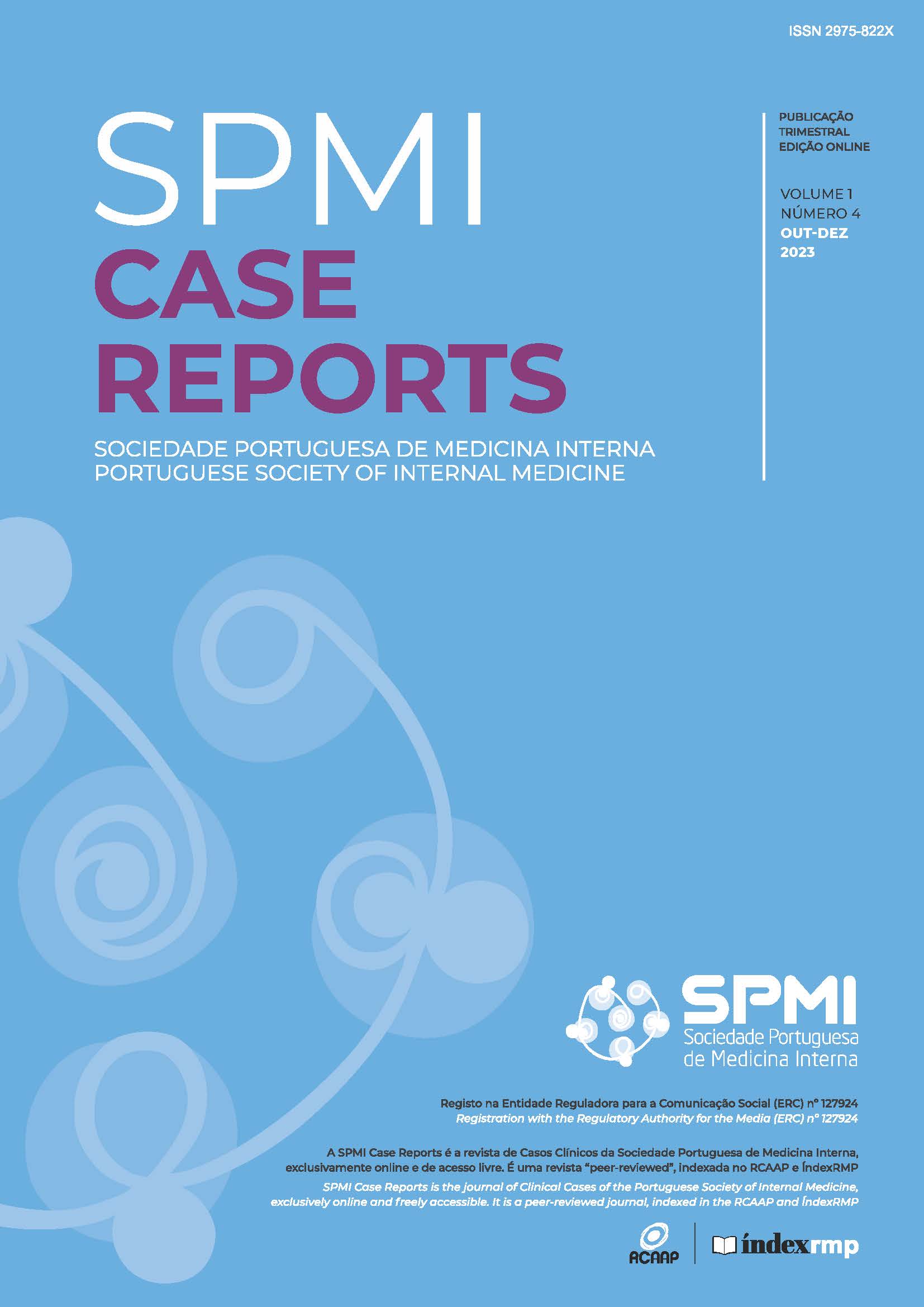Hypereosinophilic Syndrome with Skin Involvement: A Mild Case in a Severe Disease
DOI:
https://doi.org/10.60591/crspmi.113Keywords:
Hypereosinophilic Syndrome/diagnosis, Hypereosinophilic Syndrome/drug therapy, Skin/pathologyAbstract
Hypereosinophilic syndromes are a group of rare disorders defined by the association of peripheral blood eosinophilia (absolute eosinophil count >1.5 x 109/L) on two examinations taken at least one month apart, eosinophil-mediated organ damage and/or dysfunction, with exclusion of other potential causes.
We present a case of an 89-year-old woman with purpuric lesions on both legs, beginning the past few months. Physical examination revealed multiple scattered purpuric macules in the lower limbs and diagnostic work-up showed eosinophilia (19.82 x 109/L) and high immunoglobulin E (709 U/L) without any remarkable other change. Skin biopsy showed superficial dermis with moderate number of eosinophils, suggestive of hypereosinophilic syndrome. The patient was treated with prednisolone 1 mg/kg for six days, presenting quick resolution of eosinophilia, without worsening after corticosteroid taper.
Downloads
References
Chusid MJ, Dale DC, West BC, Wolff SM. The hypereosinophilic syndrome: analysis of fourteen cases with review of the literature. Medicine. 1975;54:1-27.
Crane MM, Chang CM, Kobayashi MG, Weller PF. Incidence of myeloproliferative hypereosinophilic syndrome in the United States and an estimate of all hypereosinophilic syndrome incidence. J Allergy Clin Immunol. 2010;126:179-81. doi: 10.1016/j.jaci.2010.03.035.
Dispenza MC, Bochner BS. Diagnosis and Novel Approaches to the Treatment of Hypereosinophilic Syndromes. Curr Hematol Malig Rep. 2018;13:191-201. doi: 10.1007/s11899-018-0448-8
Ackerman SJ, Bochner BS. Mechanisms of eosinophilia in the pathogenesis of hypereosinophilic disorders. Immunol Allergy Clin North Am. 2007;27:357-75. 10.1016/j.iac.2007.07.004
KM, Nutman TB, Pfab F, Ring J, Rothenberg ME, Roufosse F, Sajous MH, Sheikh J, Simon D, Simon HU, Stein ML, Wardlaw A, Weller PF, Klion AD. Hypereosinophilic syndrome: a multicenter, retrospective analysis of clinical characteristics and response to therapy. J Allergy Clin Immunol. 2009;124:1319-25.e3. doi: 10.1016/j.jaci.2009.09.022.
Vaklavas C, Tefferi A, Butterfield J, Ketterling R, Verstovsek S, Kantarjian H, et al. 'Idiopathic' eosinophilia with an Occult T-cell clone: prevalence and clinical course. Leuk Res. 2007;31:691-4. doi: 10.1016/j.leukres.2006.10.005.
Bain BJ. Eosinophilia - idiopathic or not?. N Engl J Med. 1999;15:1141 -3. doi: 10.1056/NEJM199910073411509
Valent P, Klion AD, Horny HP, Roufosse F, Gotlib J, Weller PF, et al. Contemporary consensus proposal on criteria and classification of eosinophilic disorders and related syndromes. J Allergy Clin Immunol. 2012;130:607-12.e9. doi: 10.1016/j.jaci.2012.02.019.
Weller PF, Bubley GJ. The idiopathic hypereosinophilic syndrome. Blood. 1994; 83:2759-79. doi: 10.1182/blood.V83.10.2759.2759
Valent P, Klion AD, Horny HP, Roufosse F, Gotlib J, Weller PF, Hellmann A, Metzgeroth G, Leiferman KM, Arock M, Butterfield JH, Sperr WR, Sotlar K, Vandenberghe P, Haferlach T, Simon HU, Reiter A, Gleich GJ. Contemporary consensus proposal on criteria and classification of eosinophilic disorders and related syndromes. J Allergy Clin Immunol. 2012 Sep;130(3):607-612.e9. doi: 10.1016/j.jaci.2012.02.019.
Leiferman KM, Gleich GJ, Peters MS. Dermatologic manifestations of the hypereosinophilic syndromes. Immunol Allergy Clin North Am. 2007;27:415-41. doi: 10.1016/j.iac.2007.07.009
Kuang FL, Klion AD. Biologic agents for the treatment of hypereosinophilic syndromes. J Allergy Clin Immunol Pract. 2017;5:1502-9. doi: 10.1016/j.jaip.2017.08.001.
Fauci AS, Harley JB, Roberts WC, Ferrans VJ, Gralnick HR, Bjornson BH. NIH conference. The idiopathic hypereosinophilic syndrome. Clinical, pathophysiologic, and therapeutic considerations. Ann Intern Med. 1982;97:78-92. doi: 10.7326/0003-4819-97-1-78.








